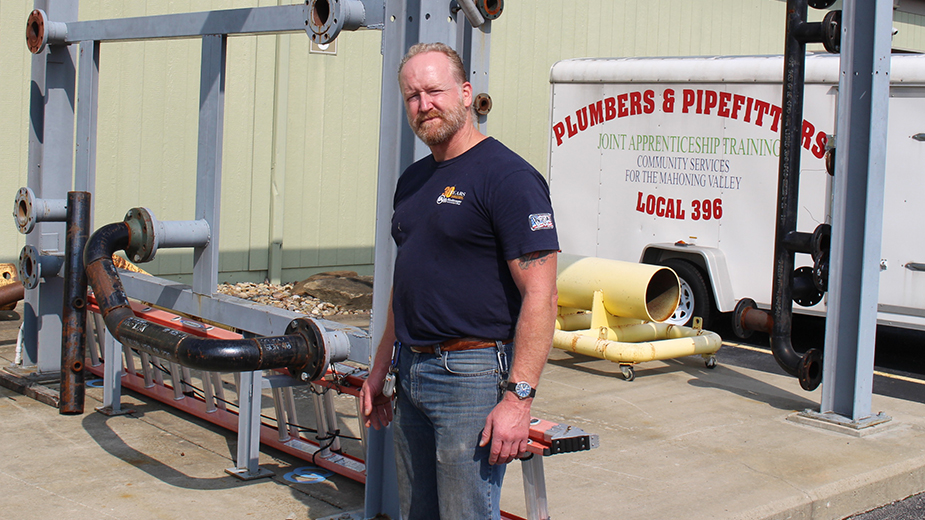YOUNGSTOWN, Ohio – Richard Boyarko has 73 apprentices signed up this scholastic year at Plumbers and Pipefitters Local 396.
The union’s training director says as many as 20 of them, after five years of classroom and hands-on instruction, become journeymen every year. He draws 40% of his apprentices from area trade schools.
Boyarko says there are large contractors working in this area who need trained pipefitters to help complete their projects, such as the Ultium Cells LLC plant in Lordstown and the Shell Pennsylvania Petrochemicals Complex in Monaca, Pa.
“The perfect pipefitter is someone who is mechanically inclined,” Boyarko says. “You should have a good work ethic. That’s what we prefer.”
According to the Local 396 building trades apprenticeship wage schedule, the first-year worker makes no less than $13.74 an hour, rising to $30.60 after five years in the program. By including the pension, health care and other benefits, the hourly compensation rises to $51.67 after five years.
George Brown, executive director of the Ohio Oil and Gas Energy Education Program, says jobs in the oil and gas industry are not limited to pipefitters. There are more than 75 fields in Ohio, with most jobs in welding, truck driving and engineering.
As of Aug. 19, there are 1,140 jobs available when you type in the keywords “oil and gas” on OhioMeansJobs.com.
“[OhioMeansJobs has] determined that careers in oil and gas pay on average $30,000 more than other fields and average roughly $81,000 a year,” Brown says. “So these are good, high-paying jobs and the skill set and levels run a wide gamut. Places to get training is a pretty full spectrum, too.”
Brown says there is plenty of oil and gas training from Youngstown State University to the Utica Shale Academy in Salineville to the area trade schools. In addition, he says his organization is partnering with Oh Wow! The Roger & Gloria Jones Children’s Center for Science & Technology to teach younger children about these jobs and hopefully spur their interest toward these professions – an endeavor that is slated to happen this fall.
“So the Valley is uniquely positioned with all of these incredible assets and community partners to address some of the workforce challenges that are out there and help people get these very good paying jobs,” Brown says.

Trumbull Career and Technical Center high school welding fabrication instructor Robert Olesky says TCTC had a summer camp with 15 eighth-graders taking his class. The young people did not want to stop welding after the week’s end.
“I know in three years, half of those kids are going to be enrolled in this class,” he says.
Introducing children to the trades at earlier ages is something Olesky wants to see. He presents mini courses on carpentry, bricklaying, electrical tech, heating and air conditioning, and welding to combat the employee shortages in these fields.
Olesky teaches juniors and seniors, starting them with basic learning because some have never even used a hammer or screwdriver.
“Mom, Dad, give your kids a chance,” he says. “Let them work with their hands. Let them get dirty. Let them get burnt. Let them try it out. The old adage is if you find something you love to do, you never work a day in your life.
“Give them a chance at it. There’s such a lack of skilled trades people.”
Mike Boyle, high school welding instructor at Columbiana County Career and Technical Center, says pipe welding generally isn’t taught until senior year.
Boyle is a certified welding educator, along with being a certified welding inspector. CCCTC offers credentials before these aspiring welders come to the Plumbers & Pipefitters Local 396.
His biggest advice for his students is to be diligent in their work and practice their skills.

“Always make your next weld better than the weld that you just laid,” Boyle says. “That’s very critical. You have to be your own worst critic. Find your flaws and try to correct them immediately. Just practice. Practice all of that hand-eye coordination.
“You’ll have to get in different positions and each change quickly. Your welding technique has to change with it. You have to be ready to adapt.”
Boyle worked with his father when he was a teenager, putting in gas lines at mobile home parks. His father worked for Columbia Gas and installed pipelines around the Guilford Lake area in the 1950s, which – like any infrastructure – are starting to wear out.
“And so today, you’re starting to see a lot of pipelines that they’re doing repair work on,” he says. “I think more than ever with infrastructure, you’re going to see a lot of need for repairing pipelines.”
In addition to physical dexterity, welding requires a knowledge of mathematics.
“Although it kind of psychs the kids out a bit, they have to learn trigonometry,” Olesky says. “If you teach them how to read blueprints and how to build, they’re doing trig without knowing that they’re doing it. So, that’s a nice way around it.”
Boyle speaks of a Salem-area welder who had work in Indiana, Pennsylvania and Ohio, living quite comfortably with many tools of the trade. He sold his home and bought a camper a year ago. He is traveling the country with his wife and child pursuing pipeline opportunities across the country for at least six figures.
Others work 70, 80 and even more hours a week for what could be a six-month cycle, making more than $100,000 in half a year.
“They get used to that lifestyle,” Boyle says. “It’s a different lifestyle. But I like the guys that travel with their rigs and chase the pipelines all over the country. Those guys, they’ve committed themselves to travel.”
Pictured at top: Rick Boyarko shows a training rig at the Plumbers and Pipefitters union hall.
